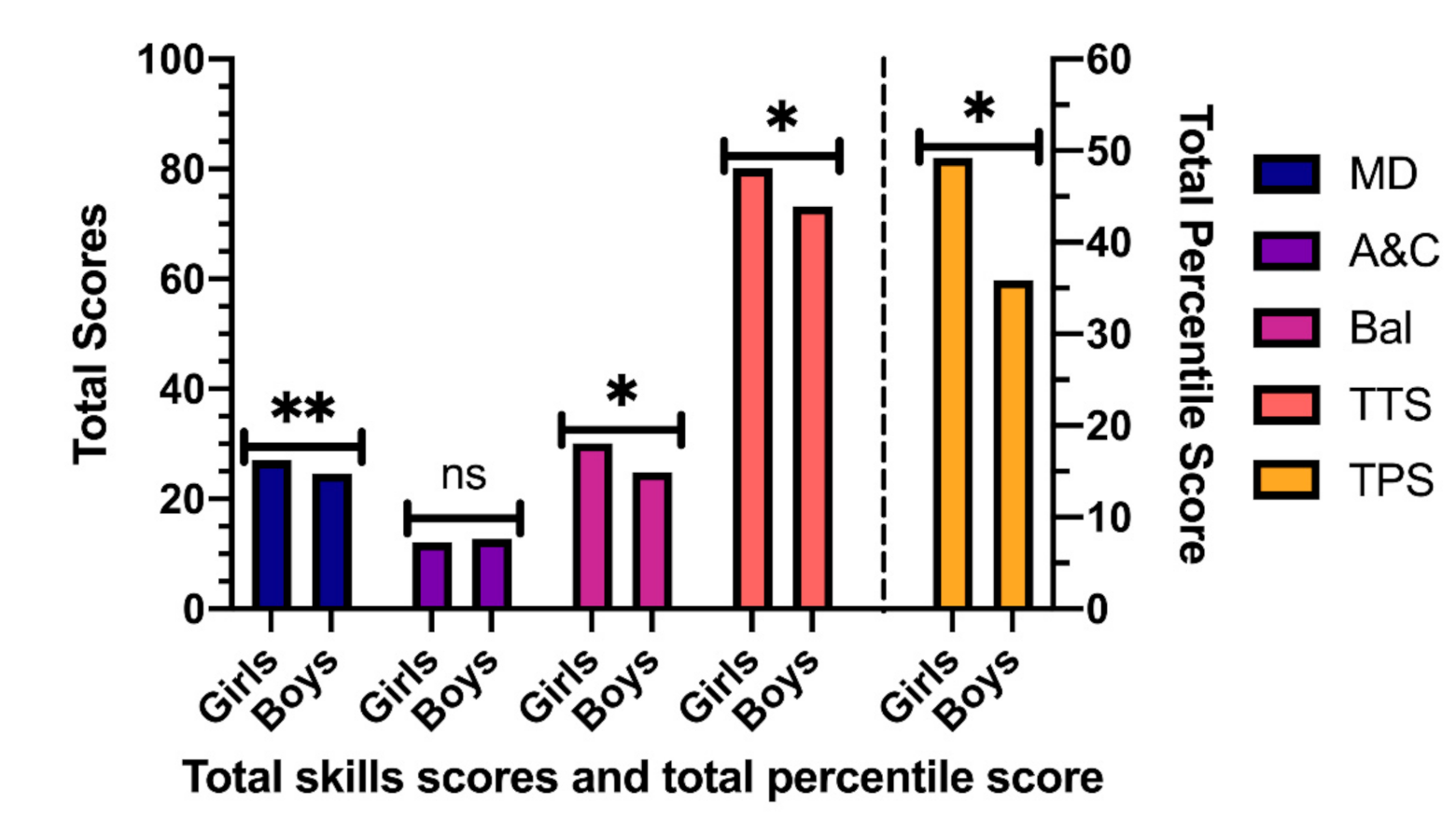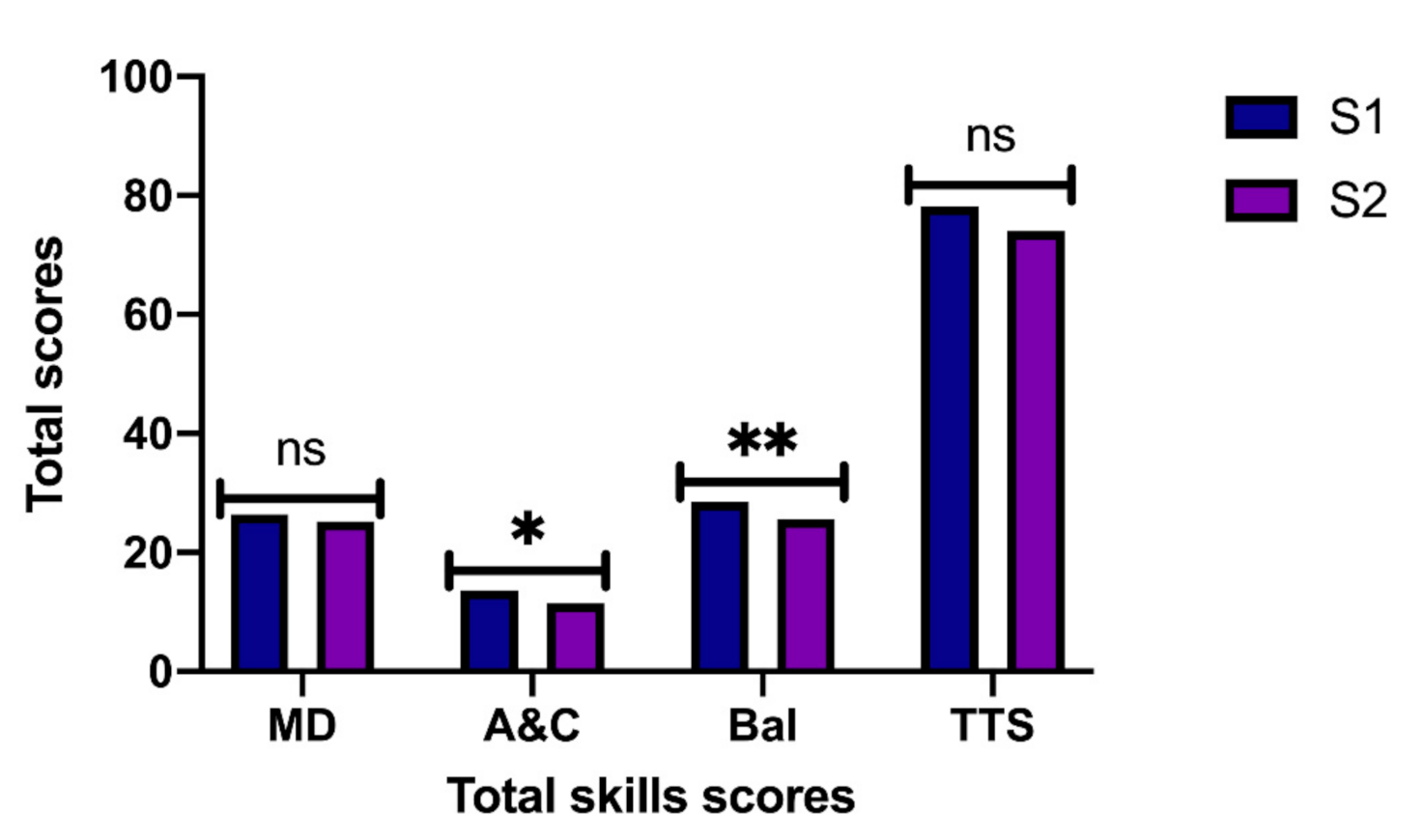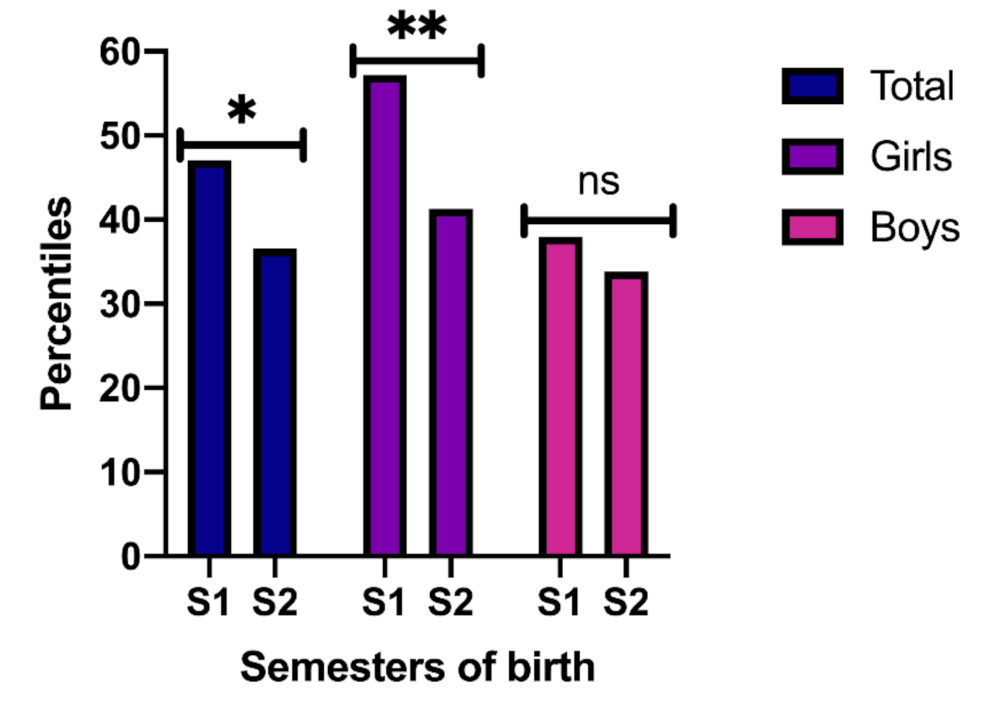Gender Differences on Motor Competence in 5-Year-Old Preschool Children Regarding Relative Age
Abstract
:1. Introduction
2. Materials and Methods
2.1. Study Design
2.2. Participants
2.3. Tools
2.4. Procedures
2.5. Statistical Analysis
3. Results
4. Discussion
5. Conclusions
6. Study Limitations and Future Proposals
Author Contributions
Funding
Institutional Review Board Statement
Informed Consent Statement
Data Availability Statement
Conflicts of Interest
References
- Arufe Giráldez, V. ¿How should Physical Education work in Early Childhood Education be? Retos 2019, 37, 588–596. [Google Scholar] [CrossRef]
- Henderson, S.E.; Sugden, D.A. Movement Assessment Battery for Children; The Psychological Corporation: Kent, UK, 1992. [Google Scholar]
- Utesch, T.; Bardid, F. Motor competence. In Dictionary of Sport Psychology:Sport, Exercise, And Performing Arts; Hackfort, D., Schinke, R., Strauss, B., Eds.; Elsevier: Berlin/Heidelberg, Germany, 2019; p. 186. ISBN 9780128131503. [Google Scholar]
- Malina, R.M.; Bouchard, C.; Bar-Or, O. Growth, Maturation, and Physical Activity; Human Kinetics: Champaign, IL, USA, 2004; ISBN 0880118822. [Google Scholar]
- Goodway, J.; Ozmun, J.C.; Gallahue, D.L. Understanding Motor Development: Infants, Children, Adolescents, Adults, 8th ed.; Jones & Barlett Learning: Boston, MA, USA, 2019; ISBN 978-443-5000. [Google Scholar]
- Clark, J.E.; Metcalfe, J.S. The mountain of motor development: A metaphor. In Motor Development: Research and Reviews; Clark, J.E., Humphrey, J., Eds.; NASPE Publications: Reston, VA, USA, 2002; pp. 163–190. [Google Scholar]
- Stodden, D.F.; Goodway, J.D.; Langendorfer, S.J.; Roberton, M.A.; Rudisill, M.E.; Garcia, C.; Garcia, L.E. A Developmental Perspective on the Role of Motor Skill Competence in Physical Activity: An Emergent Relationship. Quest 2008, 60, 290–306. [Google Scholar] [CrossRef]
- Lopes, L.; Santos, R.; Coelho-e-Silva, M.; Draper, C.; Mota, J.; Jidovtseff, B.; Clark, C.; Schmidt, M.; Morgan, P.; Duncan, M.; et al. A Narrative Review of Motor Competence in Children and Adolescents: What We Know and What We Need to Find Out. Int. J. Environ. Res. Public Health 2021, 18, 18. [Google Scholar] [CrossRef] [PubMed]
- Robinson, L.E.; Stodden, D.F.; Barnett, L.M.; Lopes, V.P.; Logan, S.W.; Rodrigues, L.P.; D’Hondt, E. Motor Competence and its Effect on Positive Developmental Trajectories of Health. Sports Med. 2015, 45, 1273–1284. [Google Scholar] [CrossRef]
- Lopes, L.; Santos, R.; Pereira, B.; Lopes, V.P. Associations between gross Motor Coordination and Academic Achievement in elementary school children. Hum. Mov. Sci. 2013, 32, 9–20. [Google Scholar] [CrossRef] [Green Version]
- Ludyga, S.; Mücke, M.; Kamijo, K.; Andrä, C.; Pühse, U.; Gerber, M.; Herrmann, C. The Role of Motor Competences in Predicting Working Memory Maintenance and Preparatory Processing. Child Dev. 2020, 91, 799–813. [Google Scholar] [CrossRef] [PubMed]
- Mulvey, K.L.; Taunton, S.; Pennell, A.; Brian, A. Head, Toes, Knees, SKIP! Improving Preschool Children’s Executive Function Through a Motor Competence Intervention. J. Sport Exerc. Psychol. 2018, 40, 233–239. [Google Scholar] [CrossRef]
- Schmidt, M.; Egger, F.; Benzing, V.; Jäger, K.; Conzelmann, A.; Roebers, C.M.; Pesce, C. Disentangling the relationship between children’s motor ability, executive function and academic achievement. PLoS ONE 2017, 12, e0182845. [Google Scholar] [CrossRef] [PubMed]
- Veldman, S.L.C.; Jones, R.A.; Santos, R.; Sousa-Sá, E.; Okely, A.D. Gross motor skills in toddlers: Prevalence and socio-demographic differences. J. Sci. Med. Sport 2018, 21, 1226–1231. [Google Scholar] [CrossRef]
- Newell, K.M. Constraints on the Development of Coordination. In Motor Development in Children: Aspects of Coordination and Control; Springer: Dordrecht, The Netherlands, 1986; pp. 341–360. [Google Scholar]
- Golding, J.; Emmett, P.; Iles-Caven, Y.; Steer, C.; Lingam, R. A review of environmental contributions to childhood motor skills. J. Child Neurol. 2014, 29, 1531–1547. [Google Scholar] [CrossRef] [PubMed] [Green Version]
- Goodway, J.D.; Famelia, R.; Bakhtiar, S. Future directions in physical education & sport: Developing fundamental motor competence in the early years is paramount to lifelong physical activity. Asian Soc. Sci. 2014, 10, 44–54. [Google Scholar] [CrossRef] [Green Version]
- Herrmann, C.; Gerlach, E.; Seelig, H. Development and Validation of a Test Instrument for the Assessment of Basic Motor Competencies in Primary School. Meas. Phys. Educ. Exerc. Sci. 2015, 19, 80–90. [Google Scholar] [CrossRef]
- Valtr, L.; Psotta, R.; Abdollahipour, R. Gender differences in performance of the Movement Assessment Battery for Children—2nd edition test in adolescents. Acta Gymnica 2016, 46, 155–161. [Google Scholar] [CrossRef] [Green Version]
- Jelovčan, G.; Zurc, J. Preschool children’s results in movement ABC test: Differences between girls and boys in movement deficit. Ann. Kinesiol. 2016, 7, 3–19. [Google Scholar]
- Kita, Y.; Suzuki, K.; Hirata, S.; Sakihara, K.; Inagaki, M.; Nakai, A. Applicability of the Movement Assessment Battery for Children-Second Edition to Japanese children: A study of the Age Band 2. Brain Dev. 2016, 38, 706–713. [Google Scholar] [CrossRef] [PubMed]
- Kokštejn, J.; Musálek, M.; Tufano, J.J. Are sex differences in fundamental motor skills uniform throughout the entire preschool period? PLoS ONE 2017, 12, e0176556. [Google Scholar] [CrossRef]
- Mathisen, G.E. Motor competence and implications in primary school. J. Phys. Educ. Sport 2016, 16, 206–209. [Google Scholar] [CrossRef]
- Olesen, L.G.; Kristensen, P.L.; Ried-Larsen, M.; Grøntved, A.; Froberg, K. Physical activity and motor skills in children attending 43 preschools: A cross-sectional study. BMC Pediatr. 2014, 14, 229. [Google Scholar] [CrossRef] [Green Version]
- Venter, A.; Pienaar, A.E.; Coetzee, D. Extent and nature of motor difficulties based on age, ethnicity, gender and socio-economic status in a selected group of three-to five-year-old children. S. Afr. J. Res. Sport. Phys. Educ. Recreat. 2015, 37, 169–183. [Google Scholar]
- Kambas, A.; Venetsanou, F.; Giannakidou, D.; Fatouros, I.G.; Avloniti, A.; Chatzinikolaou, A.; Draganidis, D.; Zimmer, R. The Motor-Proficiency-Test for children between 4 and 6 years of age (MOT 4–6): An investigation of its suitability in Greece. Res. Dev. Disabil. 2012, 33, 1626–1632. [Google Scholar] [CrossRef]
- Vincent, J.; Glamser, F.D. Gender differences in the relative age effect among US olympic development program youth soccer players. J. Sports Sci. 2006, 24, 405–413. [Google Scholar] [CrossRef]
- Aune, T.K.; Ingvaldsen, R.P.; Vestheim, O.P.; Bjerkeset, O.; Dalen, T. Relative Age Effects and Gender Differences in the National Test of Numeracy: A Population Study of Norwegian Children. Front. Psychol. 2018, 9, 1091. [Google Scholar] [CrossRef] [PubMed] [Green Version]
- McPhillips, M.; Jordan-Black, J.-A. The effect of month of birth on the attainments of primary and secondary school pupils. Br. J. Educ. Psychol. 2009, 79, 419–438. [Google Scholar] [CrossRef]
- Sprietsma, M. Effect of relative age in the first grade of primary school on long-term scholastic results: International comparative evidence using PISA 2003. Educ. Econ. 2010, 18, 1–32. [Google Scholar] [CrossRef] [Green Version]
- Cobley, S.; Abraham, C.; Baker, J. Relative age effects on physical education attainment and school sport representation. Phys. Educ. Sport Pedagog. 2008, 13, 267–276. [Google Scholar] [CrossRef]
- Dalen, T.; Ingvaldsen, R.P.; Roaas, T.V.; Pedersen, A.V.; Steen, I.; Aune, T.K. The impact of physical growth and relative age effect on assessment in physical education. Eur. J. Sport Sci. 2017, 17, 482–487. [Google Scholar] [CrossRef] [PubMed]
- Wattie, N.; Schorer, J.; Baker, J. The Relative Age Effect in Sport: A Developmental Systems Model. Sports Med. 2015, 45, 83–94. [Google Scholar] [CrossRef] [PubMed]
- Aune, T.K.; Pedersen, A.V.; Ingvaldsen, R.P.; Dalen, T. Relative Age Effect and Gender Differences in Physical Education Attainment in Norwegian Schoolchildren. Scand. J. Educ. Res. 2017, 61, 369–375. [Google Scholar] [CrossRef]
- Roberts, S.J.; Fairclough, S.J. The Influence of Relative Age Effect in the Assessment of High School Students in Physical Education in the United Kingdom. J. Teach. Phys. Educ. 2012, 31, 56–70. [Google Scholar] [CrossRef]
- Navarro-Patón, R.; Mecías-Calvo, M.; Rodríguez Fernández, J.E.; Arufe-Giráldez, V. Relative Age Effect on Motor Competence in Children Aged 4–5 Years. Children 2021, 8, 115. [Google Scholar] [CrossRef]
- Navarro-Patón, R.; Arufe-Giráldez, V.; Sanmiguel-Rodríguez, A.; Mecías-Calvo, M. Differences on Motor Competence in 4-Year-Old Boys and Girls Regarding the Quarter of Birth: Is There a Relative Age Effect? Children 2021, 8, 141. [Google Scholar] [CrossRef]
- Ato, M.; López, J.J.; Benavente, A. Un sistema de clasificación de los diseños de investigación en psicología. Ann. Psicol. 2013, 29, 1038–1059. [Google Scholar] [CrossRef] [Green Version]
- Graupera, J.L.; Ruiz, L.M. Batería de Evaluación del Movimiento para Niños-2; Pearson: Madrid, Spain, 2012; Volume 2. [Google Scholar]
- Henderson, S.E.; Sudgen, D.A.; Barnett, A. Movement Assessment Battery for Children-2, 2nd ed.; The Psychological Corporation: London, UK, 2007. [Google Scholar]
- Schoemaker, M.M.; Niemeijer, A.S.; Flapper, B.C.T.; Smits-Engelsman, B.C.M. Validity and reliability of the Movement Assessment Battery for Children-2 Checklist for children with and without motor impairments. Dev. Med. Child Neurol. 2012, 54, 368–375. [Google Scholar] [CrossRef] [PubMed]
- Valentini, N.C.; Ramalho, M.H.; Oliveira, M.A. Movement assessment battery for children-2: Translation, reliability, and validity for Brazilian children. Res. Dev. Disabil. 2014, 35, 733–740. [Google Scholar] [CrossRef] [PubMed]
- Serbetar, I.; Loftesnes, J.M.; Mamen, A. Reliability and Structural Validity of the Movement Assessment Battery for Children-2 in Croatian Preschool Children. Sports 2019, 7, 248. [Google Scholar] [CrossRef] [PubMed] [Green Version]
- Ruiz Pérez, L.M.; Graupera Sanz, J.L. Un estudio transcultural de la competencia motriz en escolares de 7 a 10 años: Utilidad de la Batería Movement ABC. Rev. Española Pedagog. 2005, 63, 289–308. [Google Scholar]
- Valentini, N.C.; Coutinho, M.T.C.; Pansera, S.M.; dos Santos, V.A.P.; Vieira, J.L.L.; Ramalho, M.H.; de Oliveira, M.A. Prevalência de déficits motores e desordem coordenativa desenvolvimental em crianças da região Sul do Brasil. Rev. Paul. Pediatr. 2012, 30, 377–384. [Google Scholar] [CrossRef]
- Vedul-Kjelsås, V.; Stensdotter, A.-K.; Sigmundsson, H. Motor Competence in 11-Year-Old Boys and Girls. Scand. J. Educ. Res. 2013, 57, 561–570. [Google Scholar] [CrossRef]
- Freitas, C.; Vasconcelos, M.O.; Botelho, M. Handedness and developmental coordination disorder in Portuguese children: Study with the M-ABC test. Laterality 2014, 19, 655–676. [Google Scholar] [CrossRef]
- Psotta, R.; Hendl, J. Movement Assessment Battery for Children—Second edition: Cross-cultural comparison between 11–15 year old children from the Czech Republic and the United Kingdom. Acta Univ. Palacki. Olomuc. Gymnica 2012, 42, 7–16. [Google Scholar] [CrossRef]
- Engel-Yeger, B.; Rosenblum, S.; Josman, N. Movement Assessment Battery for Children (M-ABC): Establishing construct validity for Israeli children. Res. Dev. Disabil. 2010, 31, 87–96. [Google Scholar] [CrossRef]
- Sigmundsson, H.; Rostoft, M.S. Motor Development: Exploring the motor competence of 4-year-old Norwegian children. Scand. J. Educ. Res. 2003, 47, 451–459. [Google Scholar] [CrossRef]
- Kourtessis, T.; Tsougou, E.; Maheridou, M.; Tsigilis, N.; Psalti, M.; Kioumourtzoglou, E. Developmental coordination disorder in early childhood-A preliminary epidemiological study in greek schools. Int. J. Med. 2008, 1, 95–99. [Google Scholar]
- Salazar Cruz, P.; Jiménez Díaz, J. Differences in the perceived motor competence of children according to the geographical region. Sport. Sci. J. Sch. Sport. Phys. Educ. Psychomot. 2020, 6, 246–265. [Google Scholar] [CrossRef]
- Cupeiro, R.; Rojo-Tirado, M.A.; Cadenas-Sanchez, C.; Artero, E.G.; Peinado, A.B.; Labayen, I.; Dorado, C.; Arias-Palencia, N.M.; Moliner-Urdiales, D.; Vidal-Conti, J.; et al. The relative age effect on physical fitness in preschool children. J. Sports Sci. 2020, 38, 1506–1515. [Google Scholar] [CrossRef]
- Gadžić, A.; Milojević, A.; Stanković, V.; Vučković, I. Relative age effects on motor performance of seventh-grade pupils. Eur. Phys. Educ. Rev. 2016, 23, 534–542. [Google Scholar] [CrossRef]
- Redondo Castán, J.C.; Fernández-Martínez, E.; Izquierdo, J.M. Efecto de la edad relativa en las disciplinas de lanzamientos de los participantes españoles en el plan nacional de tecnificación de atletismo. Cuad. Psicol. Deport. 2019, 19, 156–167. [Google Scholar] [CrossRef] [Green Version]
- Ferriz Valero, A.; Sellés Pérez, S.; García Jaén, M.; Cejuela Anta, R. Relative age effect for talents’ development in young triathletes. Retos 2019, 37, 27–32. [Google Scholar] [CrossRef]
- Morley, D.; Till, K.; Ogilvie, P.; Turner, G. Influences of gender and socioeconomic status on the motor proficiency of children in the UK. Hum. Mov. Sci. 2015, 44, 150–156. [Google Scholar] [CrossRef]
- Giagazoglou, P.; Kabitsis, N.; Kokaridas, D.; Zaragas, C.; Katartzi, E.; Kabitsis, C. The movement assessment battery in Greek preschoolers: The impact of age, gender, birth order, and physical activity on motor outcome. Res. Dev. Disabil. 2011, 32, 2577–2582. [Google Scholar] [CrossRef]
- Barnett, L.M.; Lai, S.K.; Veldman, S.L.C.; Hardy, L.L.; Cliff, D.P.; Morgan, P.J.; Zask, A.; Lubans, D.R.; Shultz, S.P.; Ridgers, N.D.; et al. Correlates of Gross Motor Competence in Children and Adolescents: A Systematic Review and Meta-Analysis. Sports Med. 2016, 46, 1663–1688. [Google Scholar] [CrossRef] [PubMed] [Green Version]
- Venetsanou, F.; Kambas, A. Environmental Factors Affecting Preschoolers’ Motor Development. Early Child. Educ. J. 2010, 37, 319–327. [Google Scholar] [CrossRef]
- Hancock, D.J.; Adler, A.L.; Côté, J. A proposed theoretical model to explain relative age effects in sport. Eur. J. Sport Sci. 2013, 13, 630–637. [Google Scholar] [CrossRef] [PubMed] [Green Version]



| Semester 1 (Born from January to June) | Semester 2 (Born from July toDecember) | ||||
|---|---|---|---|---|---|
| Total Scores | Gender | Mean | SEM | Mean | SEM |
| Manual dexterity (Post coins; Threading beads; Drawing trail 1) | boys | 24.04 | 0.92 | 25.21 * | 0.86 |
| Girls | 28.92 ** | 0.91 | 25.14 * | 0.87 | |
| Total | 26.36 | 0.68 | 25.18 | 0.39 | |
| Aiming and catching (Catching bean bag; Throwing bean bag onto mat) | boys | 13.49 | 0.66 | 11.98 | 0.58 |
| Girls | 13.75 | 0.69 | 10.46 * | 0.60 | |
| Total | 13.61 | 0.47 | 11.42 * | 0.43 | |
| Balance (One-leg balance; Walking heels raised; Jumping on mats) | boys | 26.44 | 0.77 | 23.38 | 0.97 |
| Girls | 30.85 ** | 1.02 | 29.46 ** | 1.27 | |
| Total | 28,54 | 0.66 | 25.60 *,** | 0.81 | |
| Total test Score | boys | 73.93 | 1.92 | 72.36 | 1.95 |
| Girls | 82.85 ** | 1.40 | 77.21 * | 1.79 | |
| Total | 78.17 | 1.27 | 74.14 | 1.41 | |
Publisher’s Note: MDPI stays neutral with regard to jurisdictional claims in published maps and institutional affiliations. |
© 2021 by the authors. Licensee MDPI, Basel, Switzerland. This article is an open access article distributed under the terms and conditions of the Creative Commons Attribution (CC BY) license (http://creativecommons.org/licenses/by/4.0/).
Share and Cite
Navarro-Patón, R.; Lago-Ballesteros, J.; Arufe-Giráldez, V.; Sanmiguel-Rodríguez, A.; Lago-Fuentes, C.; Mecías-Calvo, M. Gender Differences on Motor Competence in 5-Year-Old Preschool Children Regarding Relative Age. Int. J. Environ. Res. Public Health 2021, 18, 3143. https://doi.org/10.3390/ijerph18063143
Navarro-Patón R, Lago-Ballesteros J, Arufe-Giráldez V, Sanmiguel-Rodríguez A, Lago-Fuentes C, Mecías-Calvo M. Gender Differences on Motor Competence in 5-Year-Old Preschool Children Regarding Relative Age. International Journal of Environmental Research and Public Health. 2021; 18(6):3143. https://doi.org/10.3390/ijerph18063143
Chicago/Turabian StyleNavarro-Patón, Rubén, Joaquín Lago-Ballesteros, Víctor Arufe-Giráldez, Alberto Sanmiguel-Rodríguez, Carlos Lago-Fuentes, and Marcos Mecías-Calvo. 2021. "Gender Differences on Motor Competence in 5-Year-Old Preschool Children Regarding Relative Age" International Journal of Environmental Research and Public Health 18, no. 6: 3143. https://doi.org/10.3390/ijerph18063143
APA StyleNavarro-Patón, R., Lago-Ballesteros, J., Arufe-Giráldez, V., Sanmiguel-Rodríguez, A., Lago-Fuentes, C., & Mecías-Calvo, M. (2021). Gender Differences on Motor Competence in 5-Year-Old Preschool Children Regarding Relative Age. International Journal of Environmental Research and Public Health, 18(6), 3143. https://doi.org/10.3390/ijerph18063143










